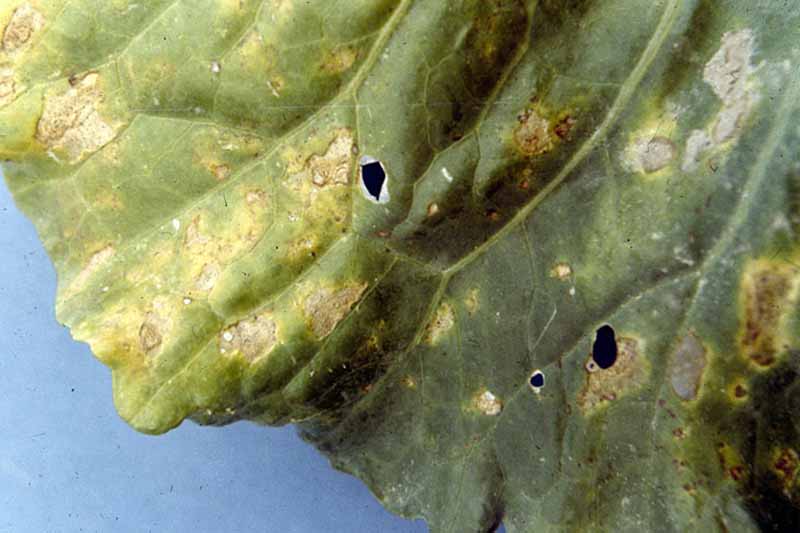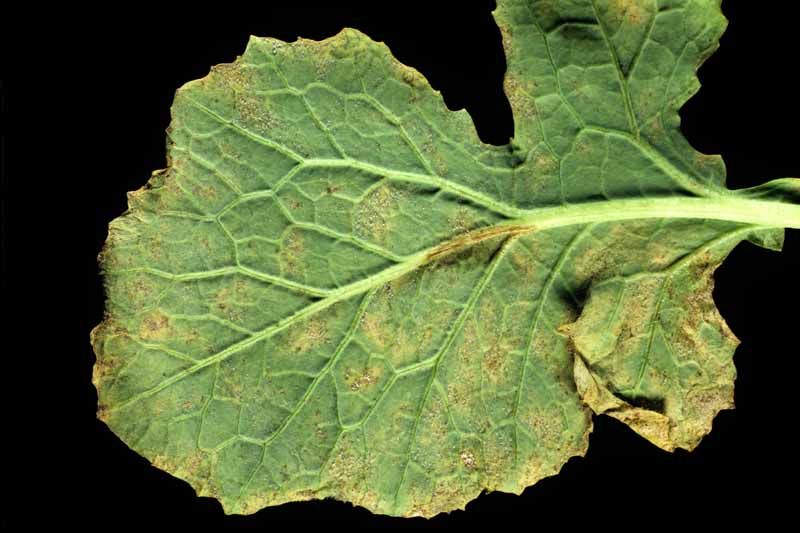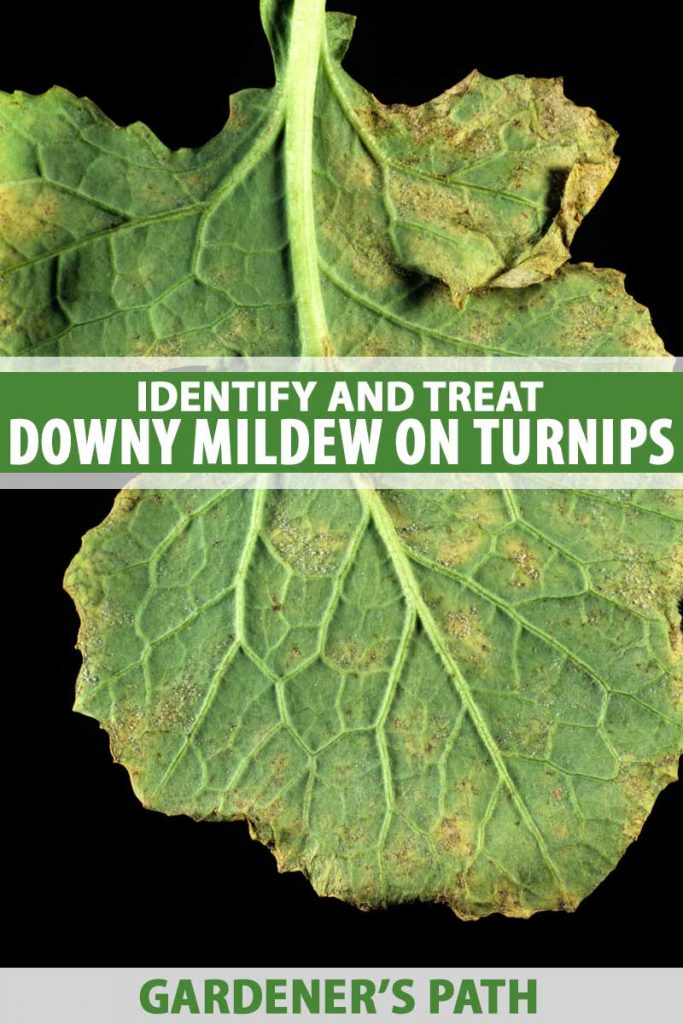Peronspora parastica
Downy mildew is a serious disease that may afflict turnips, especially under cool fall conditions.
The fungal-like pathogen can destroy young seedlings and cause serious infections on the greens. Severe infections may even cause turnips to develop cracks.
The turnip leaves may have low-level infections that are barely detectable. However, as soon as conditions are right, when moisture levels are high, the pathogen can infect your plants on a large scale.

We link to vendors to help you find relevant products. If you buy from one of our links, we may earn a commission.
Fungicides to control downy mildew on turnips are available, but you should take preventative measures first, to keep the fungus from becoming established on your crops.
Keep reading to learn more about the symptoms to look out for, with tips to protect your root crop from this fungus-like organism.
What You Will Learn
Symptoms
The microbe that causes downy mildew can affect plants at any point in their life cycle.
Downy blight symptoms usually first become visible on the lower leaves. Initially, the leaves develop small, yellow-brown spots. These spots gradually expand, with a gray or black lace-like appearance.

When conditions are right during moist weather, white fungal mats that look like mildew develop on the undersides of the leaves.
As the disease progresses, yellow areas become visible on the upper leaves. The lesions grow larger, and their centers turn bright yellow before becoming tan, with a paper-like appearance.
With severe infections, the whole leaf can die. In addition, the fungus can grow into the crown of the plant, and downward into the root.
It may turn the flesh brown or black. As the disease advances, small cracks can form on the skin of the root, and the turnip can even split open.
Alarmingly, the turnip plants can seem fine at harvest, and then deteriorate in storage, or during packing and shipping.
Downy mildew infections also make turnip plants more inclined to develop white rust.
Disease Cycle
There are mixed reports on whether seeds can be a source of downy mildew. We do know that the pathogen can overwinter on fall crops or cruciferous weeds.
Infections are favored by wet conditions – heavy dew, fog, drizzling rain, and high humidity.
Conditions that are optimal for infection occur when temperatures are between 46 and 61°F for four nights in a row, with daytime temperatures of 75°F or cooler.
The organism produces spores on the leaves that can spread to other plants, via wind or splashing water.
The pathogen can also produce a thick-walled spore called an oospore that can remain in the soil and crop residue, and infect plants during their next growing season.
Cultural Management
It is particularly critical to manage fall and spring turnip crops, since the disease spreads so rapidly during cool weather.
You should eliminate any cruciferous weeds, such as wild mustard or wild radish, since they can harbor the pathogen.
Be careful with irrigation, so that the plants are not kept excessively moist. Water the surrounding soil, not the leaves.
If downy mildew is a severe problem in your area, you may want to consider planting your turnips in the spring, and harvesting them in the summer.
Fungicide Controls
You should consider preventative sprays to control the disease if you have reason to suspect that downy mildew may be a problem.
If starting seeds indoors or in a greenhouse, spray as soon as the seedlings appear, and then three times a week until you plant your turnips in the ground.
It is important to spray every surface of the plant in order for the chemicals to work.
Home Gardeners
There are several fungicides used to treat downy mildew that are available for home gardeners.

Bonide Fung-onil Fungicide via Amazon
One option is chlorothalonil – available as Bonide Fung-onil.
Agri-Fos is also considered to be very effective at controlling downy mildew.

Reliant Systemic Fungicide (Agri-Fos/Garden Phos) via Amazon
There are also formulations of copper hydroxide (Kocide) approved for use in home gardens.

Southern Ag Liquid Copper Fungicide via Amazon
This fungicide is partially effective, but will not provide complete control.
Commercial Growers
Commercial producers have more options. There are three fungicides registered for use on turnips that are considered effective on a scale of 3 out of 4, with zero being ineffective and 4 being very effective, according to the University of Arkansas Division of Agriculture.
They include:
- Azosystrobin (Amistar, Quadris)
- Maneb (Manex)
- Pyraclostrobin (Cabrio EG)
Availability of these fungicides may vary from state to state.
Downy Mildew Can Destroy a Fall Turnip Crop
Since the pathogen that causes downy mildew thrives in cool, wet weather, fall turnip crops are especially vulnerable to this pathogen.

While you can take preventative measures, like ruthlessly culling wild crucifer plants, this can be a difficult disease to prevent. It can be present at low levels on your turnip plants, and then rapidly ramp up to high-level infection when cool wet weather arrives.
Preventive application of copper or synthetic fungicide treatments can help to control this disease if you expect it to be a problem.
Have you encountered downy mildew on your turnip plants? If so, share your experience with us in the comments.
And read on for more information on turnip diseases to include:
- How to Identify and Treat Alternaria Leaf Spot
- How to Identify and Control Black Rot
- How to Identify and Prevent White Rust
- Identify, Prevent, and Treat Bacterial Leaf Spot
© Ask the Experts, LLC. ALL RIGHTS RESERVED. See our TOS for more details. Top and bottom photos via Alamy. Product photos via Bonide, Quest Products, and Southern Ag.
